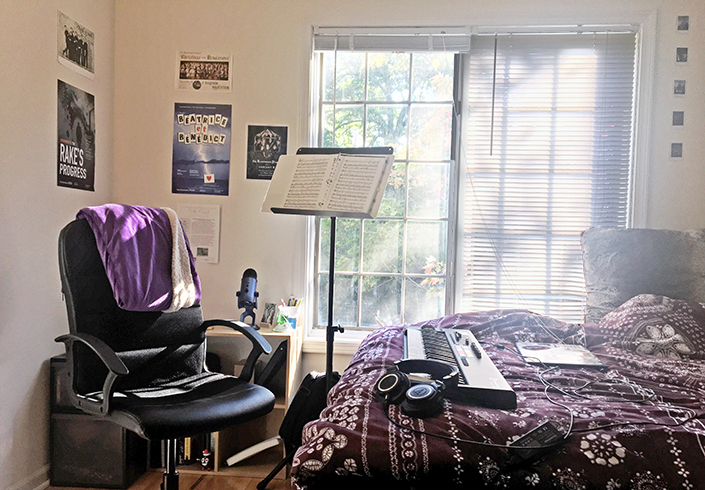By Valérie Filloux
Halfway through lugging a just-purchased wooden bookshelf half a mile to my apartment, I started to wonder about the importance of a good at-home practice area during these times. I had purchased this bookshelf for five dollars in the hopes that it would change the corner of my room, previously reserved for dirty laundry, into a space worthy of making art. COVID-19 has forced me to make my bedroom into a classroom, an exercise space, and finally, a practice room. So, how does one create an at-home practice space?
I started by asking my peers about the most important aspects of their at-home setups. Colleagues mentioned many different practical aspects, such as shelving, technology, music stands (or makeshift alternatives), room acoustics, and the size of the space. Here are three details that are applicable to every musician:
1. Investigate for any potential disturbances.
Ideally, our practice sessions will not disturb any aspects of our living situation, and we won’t be interrupted. My apartment, in which I live with three of my close friends, has a master schedule of all of our classes. This way, we know when a high C is welcome or a point of concern! We also have an active text chat in which I let my roommates know when I begin or end my practice time so that I am not disturbed. In a rush, a post-it note on your door also serves as a great reminder and a deterrent for unwanted audience members. If you live in an apartment building like I do, transparency about your situation also is extremely important. I left a large note on my front door and put notes on the surrounding apartment doors explaining my major, the general practice times I keep, and an invitation to knock on my door and talk to me if any problems arise due to my singing. So far, I’ve received no complaints and a few sweet notes from my neighbors in return!
2. Have the tools for practice.
When discussing this topic with Bienen students Andre Plackis and Valerie Mun—both undergraduate cello performance majors—each mentioned that they are flexible with where they practice and how that space looks, as long as they have the materials they need. Pencils, music stands, metronomes, and undistracted time are all part of a good practice setting. As someone who is extremely affected by her environment, the notion that any space could function as practice space surprised me. However, I realized that both Valerie and Andre have the amazing ability to feel comfortable practicing anywhere; this leads me to detail number three:
3. A space in which you feel comfortable practicing is hugely important.
If comfort means setting up a beautiful shelving unit with plants and technology side by side for aesthetics, like Bienen voice performance student Alex Wiebe, then by all means pursue that! Explore where, when, and how you feel you practice at your best, and set up accordingly. Even though we just discussed how a “perfect space” isn’t necessary for practice, I still want to address one more decorative aspect of how I set up where I practice. COVID-19 has impacted my personal motivation, and remembering why I’ve pulled out all my equipment and plugged in numerous wires has been difficult on some days. I decided to cover my practice corner’s wall in opera posters of productions I’ve participated in, posters of my family/singing-group the Renaissance Singers, and a satirical article I wrote during my freshman year (because why not?). Seeing these past achievements allows me to pull out my sheet music with a little bit more hope.
Happy practicing, everyone!
Valérie Filloux is an undergraduate voice and opera student at the Bienen School of Music.
